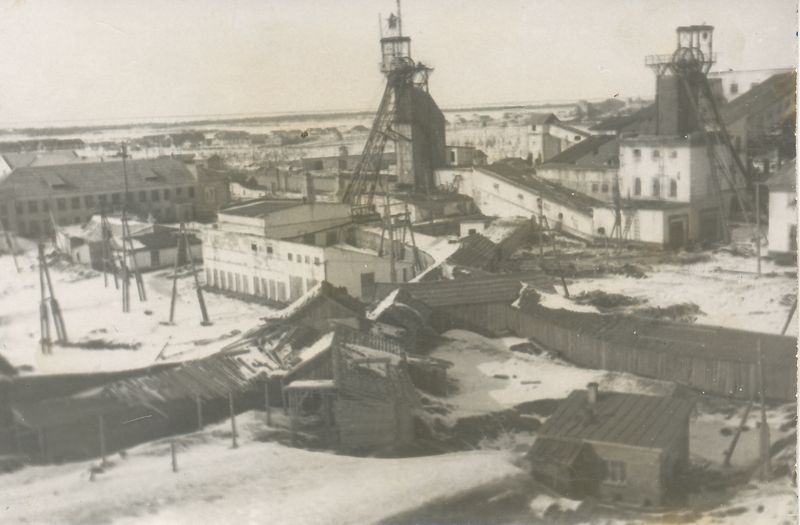Intalag on:
[Wikipedia]
[Google]
[Amazon]

 The Inta Corrective Labor Camp or Intalag (, also abbreviated Intinlag, Intlag, and Intastroy) was a forced labor camp of the
The Inta Corrective Labor Camp or Intalag (, also abbreviated Intinlag, Intlag, and Intastroy) was a forced labor camp of the
/ref> * Aleksei Kapler, film director and lover of Svetlana Alliluyeva, Stalin's daughter * Jaan Kross, Estonian writer, served a sentence in Intalag from 1947-1951, was later sent to Krasnoyarsk krai. *, opera singer, People's Artist of the RSFSR * Lina Prokofiev, Spanish singer and the first wife of Russian composerПрокофьева Лина Ивановна (урожд. Каролина Кодина; сценическое имя – Лина Любера)
/ref> * Adolfas Sruoga (1887–1941), one of the first heads of the Lithuanian Post Office * Maxim Stepanov,
Intalag
at Russian NGO
archived
the websit
was seized by Russian police
in 2008) {{Coord missing, Russia Camps of the Gulag 1941 establishments in the Soviet Union 1948 disestablishments in the Soviet Union

 The Inta Corrective Labor Camp or Intalag (, also abbreviated Intinlag, Intlag, and Intastroy) was a forced labor camp of the
The Inta Corrective Labor Camp or Intalag (, also abbreviated Intinlag, Intlag, and Intastroy) was a forced labor camp of the Gulag
The Gulag was a system of Labor camp, forced labor camps in the Soviet Union. The word ''Gulag'' originally referred only to the division of the Chronology of Soviet secret police agencies, Soviet secret police that was in charge of runnin ...
, which existed between 1941 and 1948 near the town of Inta
Inta (, ) is a types of inhabited localities in Russia, town in the Komi Republic, Russia. Population:
History
Inta was founded around 1940 as a settlement to support a geological expedition to explore coal deposits and projecting of mines. The ...
in the Komi Autonomous Soviet Socialist Republic. Prisoners at the camp were mainly engaged in the mining of local coal deposits.
History
Intalag was established on 17 November 1941 by being separated from Vorkutlag. Despite its name, the camp was not actually located at Inta until 1942, being initially located atVorkuta
Vorkuta (; ; Nenets languages, Nenets for "the abundance of bears", "bear corner") is a coal-mining types of inhabited localities in Russia, town in the Komi Republic, Russia, situated just north of the Arctic Circle in the Pechora coal basin a ...
. The first camp commander was Captain Mikhail Savich Zdunis, who led it until 17 July 1942, and it was subordinated to the General Directorate of Railway Construction Camps (GULZHDS). The camp's prisoners were tasked with mining the Inta coal deposit and building and operating (from 11 September 1942) the Inta Central Electric System. On 27 July, Senior Lieutenant V.P. Sokolov took command of the camp, replacing Zdunis. Major G.B. Orlovsky became the camp commander on 26 March 1943. The camp was transferred to the General Directorate of Mining and Metallurgy Camps (GULGMP) on 5 October. Colonel M.I. Khaleyev became camp commander on 16 September 1944, and would command the camp for the rest of its existence. The Shchugorugol camp was split off from Intalag on 15 September 1945, but reabsorbed at the end of 1946. At the beginning of 1947, the number of inmates in the camp reached 20,585, its highest size. On 30 October 1948, the camp was closed down and reorganized into Minlag, an MVD special camp for political prisoners.
Notable inmates
* Dmitry Dudko, Orthodox priest and former dissident * Yuli Dunsky, Soviet screenwriter * Valeri Frid, Soviet screenwriterЮлий Дунский и Валерий Фрид/ref> * Aleksei Kapler, film director and lover of Svetlana Alliluyeva, Stalin's daughter * Jaan Kross, Estonian writer, served a sentence in Intalag from 1947-1951, was later sent to Krasnoyarsk krai. *, opera singer, People's Artist of the RSFSR * Lina Prokofiev, Spanish singer and the first wife of Russian composer
Sergei Prokofiev
Sergei Sergeyevich Prokofiev; alternative transliterations of his name include ''Sergey'' or ''Serge'', and ''Prokofief'', ''Prokofieff'', or ''Prokofyev''. , group=n ( – 5 March 1953) was a Russian composer, pianist, and conductor who l ...
/ref> * Adolfas Sruoga (1887–1941), one of the first heads of the Lithuanian Post Office * Maxim Stepanov,
Red Army
The Workers' and Peasants' Red Army, often shortened to the Red Army, was the army and air force of the Russian Soviet Republic and, from 1922, the Soviet Union. The army was established in January 1918 by a decree of the Council of People ...
officer (died at Intalag in 1945)
References
Citations
Bibliography
* * *External links
Intalag
at Russian NGO
Memorial
A memorial is an object or place which serves as a focus for the memory or the commemoration of something, usually an influential, deceased person or a historical, tragic event. Popular forms of memorials include landmark objects such as home ...
's Virtual Museum of the Gulagarchived
the websit
was seized by Russian police
in 2008) {{Coord missing, Russia Camps of the Gulag 1941 establishments in the Soviet Union 1948 disestablishments in the Soviet Union